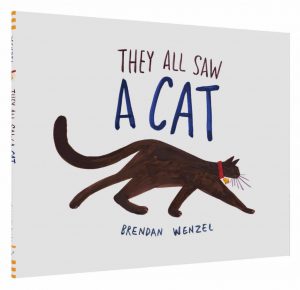We’ve all seen a cat . . . right? But author/illustrator, Brendan Wenzel, cleverly reminds us in his latest picture book that “seeing” is personal.
 They All Saw a Cat follows the same cat making its way through its neighborhood. “The cat walked through the world, with its whiskers, ears, and paws …” The cat is “seen” by a child, a dog and a fox . . . then a fish, a mouse, and a bee. It is seen by a bird, a flea, a snake, a skunk, a worm, and a bat. Each creature perceives the cat differently. The child sees a friendly pet, but the mouse sees the teeth and claws of a frightening monster. The flea sees only a jungle of fur, while the fish sees the cat magnified and distorted through the fish bowl. Personal perspective shapes and reshapes the cat in multiple ways. In the end the cat encounters its own reflection in the water . . . “and imagine what it saw.”
They All Saw a Cat follows the same cat making its way through its neighborhood. “The cat walked through the world, with its whiskers, ears, and paws …” The cat is “seen” by a child, a dog and a fox . . . then a fish, a mouse, and a bee. It is seen by a bird, a flea, a snake, a skunk, a worm, and a bat. Each creature perceives the cat differently. The child sees a friendly pet, but the mouse sees the teeth and claws of a frightening monster. The flea sees only a jungle of fur, while the fish sees the cat magnified and distorted through the fish bowl. Personal perspective shapes and reshapes the cat in multiple ways. In the end the cat encounters its own reflection in the water . . . “and imagine what it saw.”
With incredible art, a bit of science, and lyrical repetition, Wenzel has achieved a timely, visual narrative (a primer, if you will) on perspective-taking – seeing things from another’s viewpoint.
The Art – Each page is illustrated in a completely different style. Wenzel doesn’t just tweak perspectives. He creates a new vision of the cat for every creature using marker, pencil, crayon, cut paper and watercolor, acrylic and oil pastel.
The Narrative – Rhythmic, repetitive phrases become an effective way to help the reader understand that this is the same cat. “The cat walked through the world, with its whiskers, ears, and paws . . . and the child saw A CAT, and the dog saw A CAT, and the fox saw A CAT. Yes, they all saw the cat.” Articles and solid caps are used carefully throughout to reinforce perception – “A CAT” and “the cat. ”
The Science – Wenzel provides just enough scientific detail in his art to send fact-hungry children on a research quest. The worm, snake and bat pages, in particular, are bound to create a bit of speculation and student questioning.
They All Saw a Cat may be a bit confusing, at first, to the youngest children (at least until the fish page!). Younger children are still working to understand that not everyone sees the world in the same way. Perspective-taking is not yet within the realm of their cognitive development. But you can still give them a nudge in the right direction. Have fun reading the book aloud; then ask: Which picture shows the real cat? Their answers may surprise you; but then comes the eye-popper when you tell them that all of the pictures in the book are true – all show the real cat!
With older children you can delve a little deeper. This book opens the door to some thought-provoking questions: How do people see the world differently? My view might be right, but does that make your view wrong? How does taking another person’s point of view broaden our own? In these challenging times, our classrooms are ripe for these very important conversations.
